The Venice Biennale happens every two years, Documenta is on a
five-year timeline, and Münster’s Skulpture Projekte is a once-a-decade
affair.

Nancy Spero’s installation...Maypole: Take No Prisoners...greeted visitors to the Italian Pavilion...Photo by Christopher French
About 10 years ago, the Biennale’s planning committee rejigged their schedule and, presto, the big three European art shows lined up this year like so many overlapping planets producing a rare planetary configuration/ alignment. While our 10-day trek didn’t lead to an art overdose, it did produce some strong opinions about the current state of art and how it gets presented. What follows is our point-counterpoint about what we saw.
Think with the Senses—Feel with the Mind: Art in the Present Tense
2007 Venice Biennale
TS: Rob Storr organized both the keynote Arsenale and the Italian Pavilion group exhibitions, giving them an overall title that is a mouthful. This was the first time one person has organized both shows, and I really missed the sense of competing visions that animated past Biennales.
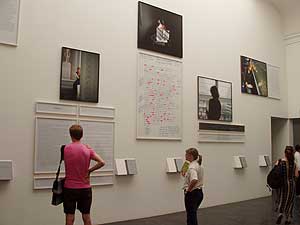
Sophie Calle...Group Therapy...Some of the 100 women who dissect the breakup letter...Sophie Calle received from her boyfriend,...in the French Pavilion...Photo by Christopher French
CF: Storr reprised many of the artists he has worked with throughout his career. In the Italian Pavilion, this produced a retrospective sensibility, most apparent in what I like to call the “all my best friends are dead gallery,” with works by Felix Gonzalez Torres (d. 1991); Jose Leonilson (d. 1993); Philippe Thomas (with Agenci Dolci dri & Associates) (d. 1995); Martin Kippenberger (d. 1997); Chen Zhen (d. 2000); Fred Sandback (d. 2003); and Sol Lewitt (d. 2007).
TS: Storr likes painting, and there was plenty of it on display in the Italian Pavilion. The few examples in the Arsenale, on the other hand, seemed gratuitous. Sigmar Polke had pride of place in the Italian Pavilion’s central gallery, but I thought his seven enormous monochrome stain paintings were outflanked and outpointed by the strictly enforced symmetries and parallels of Gerhard Richter’s six gray-green abstractions in a smaller side gallery. My top pick of the national pavilions was Sophie Calle’s ‘Prenez soin de vous’ [“Take Care of Yourself”] for France. She engaged 100 women from all walks of life to analyze the breakup letter her boyfriend sent her, often with hilarious and unsettling results. Her multimedia approach made room for humor and confrontation.
CF: My favorite video was Joshua Mosley’s Dread, a digital animation in the Italian Pavilion showing Rousseau and Pascal in oppositional discourse as they stroll through a grisaille landscape. Rousseau ponders, “God ordered all that is,” while Pascal rebuts, “God is neither here nor good.” A wild dog then kills the optimistic Rousseau.
TS: Mine was Francesco Vezzoli’s democracy, which was placed in a special pavilion constructed at the end of the Arsenale for Italian artists. Vezzoli’s licentious Remake of Gore Vidal’s Caligula (now on permanent display at the Museum Ludwig in Cologne) was one of the big hits of the 2005 Biennale. Here Vezzoli again used actors and public figures (Sharon Stone and Bernard-Henri Lévy), this time to stage fictitious “his and her” political ads for Patricia and Patrick Hill. It was funny, biting satire, with a whiff of the anti-American sentiment that lurked in many Biennale artworks.

Belgian Jan Fabre...Bath-a-day self-portrait in siliconed bronze and water...The Man Writing on Water...2006...From his solo exhibition at the Palazzo Benzon...Photo by Christopher French
CF: Luca Buvoli’s installation introduced the Arsenale show. Luca used this place of prominence well, combining architecture, sculpture, wall painting and video in an optimistic take on modernist utopias. His installation established one of the exhibition’s motifs: Artists paraphrased modernist ideals like archeologists reconstructing vessels from pottery shards unearthed on a dig. This was evident in Yang Fudong’s Seven Chinese Intellectuals in a Bamboo Forest, a stylish, soulful black-and-white video shot in 1930s documentary style. Fudong scattered five 30-minute, 35mm film installments in boxy cubicles throughout the Arsenale’s long hall. Venice’s hot weather turned these mini-theaters into sweatboxes and the work into an endurance test. We managed to sit through most of it, watching the transition from dandified poets to oversexed dissolutes, from mud-spattered rice farmers to imperiled refugees.

Yin Xiuzhen...Floating Tiger, Macramé Dragon...Detail of Yin Xiuzhen’s Arsenal...In the People’s Republic of China pavilion...Photo by Christopher French
TS: Thwarted or overturned utopias were constant themes, along with lots of navel-gazing about death. I loved Angelo Filomeno’s glittering, bejeweled skeletons living their lonely lives. On the other hand, Yang Zhenzhong’s multiscreen video projection I Will Die, which featured people from all over the world repeating the title, was a less-than-successful distillation of Peggy Lee’s “Is That All There Is?” I preferred Oscar Muñoz’s quickly evaporating portraits, made in water on stone, of the disappeared, and Emily Prince’s thumbnail portraits of American soldiers killed in Iraq, geographically arranged into a map of the United States.
CF: The real standout among Venice’s many Biennale-related exhibitions was Artempo: Where Time Becomes Art at the Fortuny Museum. Where else can you see a burned portrait of a procurator from the School of Tintoretto next to Alberto Burri’s Cellotex (1976)? Or Lucio Fontana’s Golden Concetto Spaziale (1962) communing with an African elephant’s ear? Or a Roman marble torso of a youth (1st-2nd century) triangulating with Francis Bacon’s astringent Study from the Human Body (1986), Kimsooja’s moody A Laundry Woman, Yamuna River, India (2000) and Anish Kapoor’s monumental Mirror “S-Curve” (2006)?
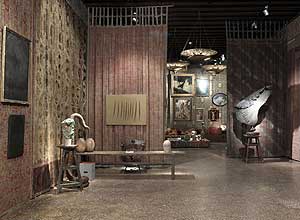
Artempo @ Fortuny Museum...Artempo’s 2nd floor installation...Emphasized a mix-and-match approach...unifying art and artifacts...with intricately patterned fabrics...ornate light fixtures,...representational paintings and plaster casts.
TS: Definitely the biggest wunderkammer I have ever seen. Belgian Axel Vervoordt’s collection forms the core of this show, and it is full of contradictory impulses: old versus new, sacred versus profane, minimal versus opulent, brut versus refined. The all-star exhibition team (Mattijs Visser, Jean-Hubert Martin, Giandomenico Romanelli and Daniela Ferretti) made Fortuny’s intricate textiles, lighting fixtures, paintings and plaster casts an integral part of the show, aiding an understanding of so many disparate objects. This was easily the best show we saw in Venice — and the most dynamic use of this space I have seen since Peter Greenaway’s equally dramatic 1993 exhibition Watching Water.
Documenta 12
TS: Putting together the 2007 Biennale shows was one person’s job. One couple — German curator Roger Buergel and his art historian wife, Ruth Noack —organized Documenta 12. Conceptually all over the map, it sprawled across Kassel, encompassing five buildings — Fridericianum Museum, Documenta Hall, Aue Pavilion, Neue Gallery and Schloss Wilhemshöhe — plus sited works in supplemental locations. Still, Documenta 12 seemed both smaller in scale and less ambitious than previous editions.
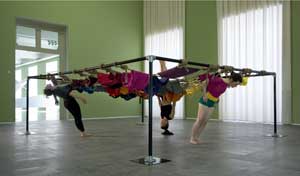
Dancers activate Trisha Brown's...Floor of the Forest...1970...© Trisha Brown; photo Katrin Schilling
CF: Less coherent, perhaps. On the plus side, Documenta traditionally gives prominence to a lot of interesting artists not well known outside of their Asian, African, Eastern European or South American bases. On the downside, Documenta tends to wax nostalgic for artists who came of age during the last throes of modernism. I found Trisha Brown’s 1970 sculpture-cum-performance Floor of the Forest very entertaining, but the Grateful Dead’s “Uncle John’s Band,” which accompanied the revival of her 1971 performance Accumulation, conveyed past tenses, not present realities or future possibilities. There was also a weird overreliance on a handful of artists — Kerry James Marshall, Juan Davila, John McCracken, Ai Weiwei — whose work reappeared in each venue like obscure lodestones or highway mileposts.
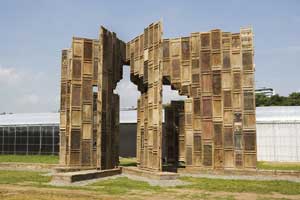
All Fall Down...Ai Weiwei’s Template...Made from Ming and Qing Dynasty chairs...In front of the Aue Pavilion...Photo: Frank Schinski
TS: Designed especially for this exhibition, the Aue Pavilion was an architectural disaster. Not only did it look like an agricultural fair exhibit hall, it overheated like one, too. Its red-orange floors and colored walls were stridently anti white cube, with artworks scattered throughout with no rhyme or reason, although observing the contrast between one of McCracken’s tantric paintings from the 1970s and a 19th-century Tajikistan bridal veil almost made the long trek through the pavilion worthwhile. I liked the juxtaposition of historical and contemporary works in the Schloss Wilhemshöhe, but the catalogue’s affected approach to artworks ranging from the 14th century to the present replaced alphabetical artist listings with a timeline. Unfortunately, this gave the appearance of a show organized by randomly sampling art magazines and history books. Fortunately, the catalogue also came with an index.
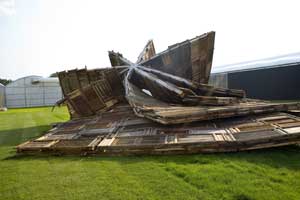
All Fall Down...Ai Weiwei’s Template...Made from Ming and Qing Dynasty chairs...In front of the Aue Pavilion...Photo: Julia Zimmermann
CF: As in past Documentas, some of the best works were ephemeral or sited outdoors, like Sanja Ivekovic’s red poppies replacing the grassy quadrangle in front of the Fridericianum. I immediately thought of The Wizard of Oz (“Poppies, to make them sleep”), but the political anthems he broadcast across the square throughout the day suggested a Marxist “opium for the masses” interpretation. Ai Weiwei’s Fairytale paired 1,001 Chinese visitors to Kassel with 1,001 Qing Dynasty (1644-1911) chairs scattered throughout the exhibition galleries. After the visitors left, the chairs remained, offering respite to footsore art-sloggers. His Template arranged Qing Dynasty doors into an outdoor ziggurat that collapsed into an equally interesting abstract sculpture after a thunderstorm blew it down.
TS: The Neue Gallery’s dimmer light, by contrast, conveyed a sense of interior calm and accommodated lots of delicate works on paper that allowed art to do what it is supposed to do — invite you to look and think. One of my favorites there was James Coleman’s Retake With Evidence, a film projection proving once again that cinema is, at its best, pure image/text juxtaposition and that the best artists are increasingly going Hollywood. I couldn’t identify the searing, post-battle soliloquies Harvey Keitel delivered, and Coleman didn’t give any clues, but his text, which could have been written by Shakespeare or Aeschylus, seemed aimed squarely at the Iraq morass.
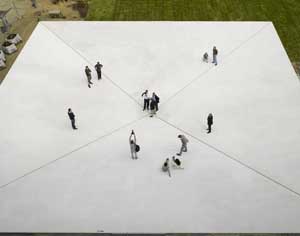
Thirty years in the making:...Proposed for the first Projekte,...Bruce Nauman’s Square Depression...was realized for the fourth...Photo: Arendt Mensing
Skulpture Projekte Münster 07
TS: This was my third Projekte, and because Kaspar König always heads the curatorial team, I have found this to be the most stimulating of the big European exhibitions. The 2007 version, however, was definitely Projekte-lite, as if its budget had been severely cut. This was only amplified by a retrospective show of past Projekte projects at Münster’s Landesmuseum.
CF: Perhaps they spent all of their money finally realizing Bruce Nauman’s enormous concrete Square Depression, which he first proposed for Projekte 77. But while I agree that this show seemed much more Spartan, the Landesmuseum retrospective reminded me of the ephemeral, experimental or even slight nature of many previous Projekte artworks. This show may not always produce great art, but it is always great fun; replacing Venice’s heat wave with Germany’s temperate climate made riding a bike from outdoor sculpture to outdoor sculpture a pleasure.
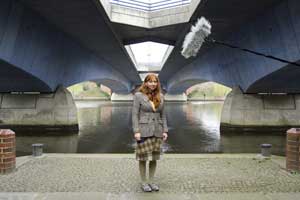
Susan Phillipsz...Standing under the Tormin Bridge...the site for her sound installation...The Lost Reflection...Photo: Roman Mensing
TS: Some of my favorites pieces were sonic. Susan Philipsz sited her elegiac call-and-response sound piece The Lost Reflection under the Tormin Bridge that crosses Lake Aa; Pae White used carillons throughout town to chime out her favorite love songs. Suchan Kinoshita’s Chinese Whispers installed viewers in a storefront vitrine, putting them on display while they listened to a whispered game of “telephone.”
CF: The weakest works here, like Maria Pask’s commune revivalist Beautiful City and Mike Kelley’s Petting Zoo, came across as retro social science experiments.
TS: But I remember you petting more than one of Kelley’s goats! Petting Zoo was a real crowd-pleaser, especially for children: I found it both creepy and compelling. And Hans-Peter Feldmann’s cheerfully decorated WC Facilities on the Domplatz was a positivistic intervention in the spirit of Joseph Beuys’s 1977 “rehabilitative” fat sculpture of a tawdry Münster underpass. Still, I agree that no socially interactive work sparked the revelation Janet Cardiff’s 1997 Walk Munster l and ll had produced in me.
CF: Petting Zoo simply came across as wacky — I preferred the humorous inventiveness of Tue Greenfort’s Diffuse Entries, which transformed a machine for spreading liquid manure into a respectable fountain energetically spraying clean water into one end of Lake Aa.
TS: For social critique, nothing beat Andreas Siekmann’s Trickle Down: Public Space in the Era of Its Privatization for pointed commentary. His politicized carousel, On the Politics of the Excluded Fourth, coexisted at Documenta with Sanja Ivekovic’s red poppies. Here his work occupied the same noble’s baroque palace that Richard Serra’s steel sculpture so notably affronted in 1987. Trickle Down critiques Adam Smith’s free market theories via the proliferation of exhibits of decorated animals that celebrate a city’s identity (including 55 “Cow Parades” around the world — and, yes, Houston’s 2001 painted cow extravaganza was well represented here). A ball of crushed animals and a giant trash compactor square off, and while the animals do not come out winners, they are definitely more interesting in their new “group” identity.
The Venice Biennale remains on display through November 12.
Artempo: Where Time Becomes Art remains on view at the Fortuny Museum, Venice, through October 7.
Documenta 12 remains on view in Kassel, Germany, through September 23.
Skulpture Projekte Münster 07 remains on view in Münster, Germany, through September 30.
Images courtesy the writers
Christopher French and Terrie Sultan have written for Glasstire before about their summer travels. Read the one from last year all about Scandanavia!


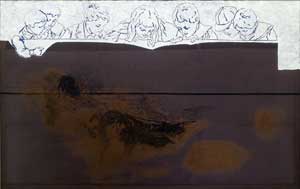

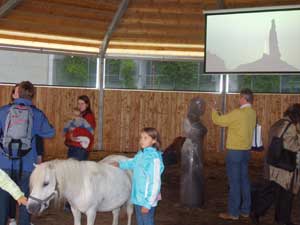



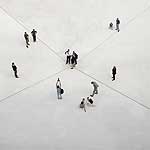

1 comment
I am curious about other travelers this summer and would like to hear what they have to say about the shows. Anyone?